Discover 11 hidden attractions, cool sights, and unusual things to do in Bury (United Kingdom). Don't miss out on these must-see attractions: Peel Monument, Clarence Park, and Gigg Lane. Also, be sure to include Bury Market in your itinerary.
Below, you can find the list of the most amazing places you should visit in Bury (England).
Table of Contents
Peel Monument
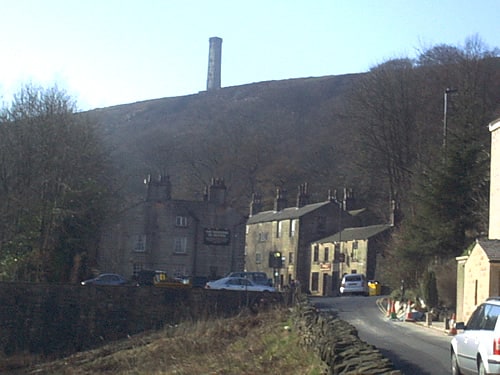
Monument in Holcombe, England. The memorial tower to Sir Robert Peel, high above Ramsbottom was planned and erected at the same time as Bury was preparing its statue to the then recently deceased statesman who was born in Bury.
The tower occupies a prominent position on Harcles Hill (known locally as "Holcombe Hill" due to its location next to Holcombe village) 1,100 feet (335 m) above sea level. The monument is believed to have been designed by members of the memorial committee who included the local textile entrepreneur and philanthropist William Grant. Grant was said to have been responsible for the site, which was in a direct line from his own house, Nuttall Hall and St Andrew's Church.
A public subscription provided the £1,000 needed to build the tower. The stone for the tower was obtained from the hillside. The Peel Tower was opened in September 1852, the day after the inauguration of the Baily's statue in Bury.
As at the earlier ceremony Frederick Peel was the principal guest of honour, and he declared the monument to be a splendid memorial to his father and to the principles of free trade. Local speakers included Joshua Knowles and John Robinson Kay. Unfortunately, large numbers who had travelled by excursion train from Salford arrived too late to witness the ceremony.
Inside the entrance to the tower is an extract from Peel's speech to the House of Commons in 1846. It emerged later that the tower had been planned and built in such haste that the necessary permission had not been obtained from the owner of the land, the Duke of Buccleuch. This matter was eventually rectified in 1868 when the land was transferred into the keeping of six trustees, on the condition that it would not be used for contentious public meetings.
If the tower, in the words of the Manchester Guardian, is not "a specimen of architectural beauty", it does provide a conspicuous landmark, and it also has a viewing platform from which to look across the surrounding countryside. The original internal staircase eventually became unsafe and was bricked up; later, the tower was reconditioned and a new staircase provided. The tower is 128 feet (39 m) high. A local Easter tradition entails people walking up the hill on Good Friday, often rolling hard-boiled eggs down the steep sides.
The tower was renovated in 1929 and at various other times. The tower closed after the Second World War in 1947 and was reopened and rededicated in November 1985 by Conservative Councillor Alice Maders. The tower was then floodlit later that decade.[1]
Address: Harcles Hill, Bury
Clarence Park

Park in Bury, England. Clarence Park is a Green Flag awarded public park located in Bury, Greater Manchester. It is the largest urban park in the borough, and was opened to the public in 1888.
The park's facilities include a bandstand, a skate park, tennis courts, a children's play area, a skate park, bowling green, a football pitch and a café.
A lido with parking facilities offers angling opportunities and is home to a model boat club. Originally a reservoir, it was opened to the public in 1963.[2]
Gigg Lane
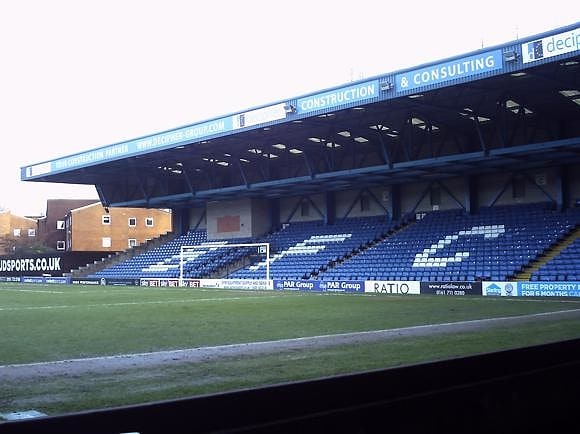
Stadium in Bury, England. Gigg Lane is a football ground in Bury, Greater Manchester, England, built for Bury F.C. in 1885. The first match was played on 12 September 1885 between Bury and a team from Wigan. One of the world's oldest professional football stadiums, Gigg Lane was in continuous use by Bury until August 2019 when the club was expelled from the English Football League. The ground's last competitive match was on 4 May 2019 when Bury hosted Port Vale.
In November 2020, Bury F.C. was placed in administration and the ground was later put up for sale by the administrator. In February 2022, the Est.1885 fans' group completed a deal to purchase the entire property. They also acquired the trading name and memorabilia of Bury F.C. The new owners formed the company Gigg Lane Stadium Limited and stated their intention to reopen the ground as a football venue by August 2022.
Gigg Lane has four covered stands and has been an all-seater stadium since 2000. Its capacity when last used in 2019 was 11,840. The record attendance is 35,000 for an FA Cup tie in 1960 when the stands were nearly all terraced. FC United of Manchester had a ground-sharing agreement with Bury from 2005 to 2014. Besides football, the ground has been used for other sports including rugby league – it was the home of Swinton Lions for ten years from 1992.[3]
Address: Gigg Ln, BL9 9HR Bury
Bury Market
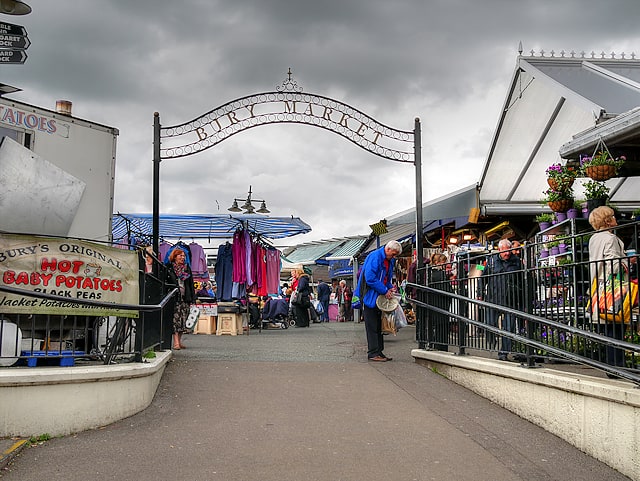
Market in Bury, England. Bury Market is an open-air market in the town of Bury, Greater Manchester, England. It consists of a large market hall, with extensive stalls outside, selling fruit, flowers, clothing, hardware and groceries.
A new fish and meat market hall was constructed in the 1990s on the site of a former National Westminster Bank. The market opens on Wednesdays, Fridays and Saturdays, and attracts visitors from miles around. It is famed for its black pudding stalls and is near Bury's main shopping centre, Mill Gate. The open air market is only open on Wednesday, Friday and Saturday but the indoor market is open every day except Sunday.[4]
Address: 1 Murray Rd., BL9 0BJ Bury
The Fusilier Museum
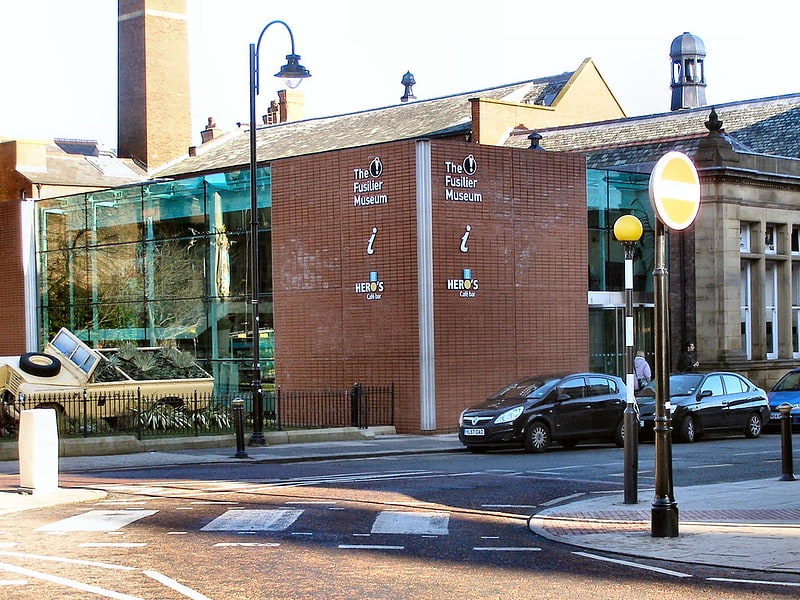
Museum in Bury, England. The Fusilier Museum is a museum in Bury, Greater Manchester, England. Its collection includes the uniforms, medal and artefacts of the Lancashire Fusiliers.[5]
Address: Moss St., BL9 0DF Bury
Radcliffe Town Hall
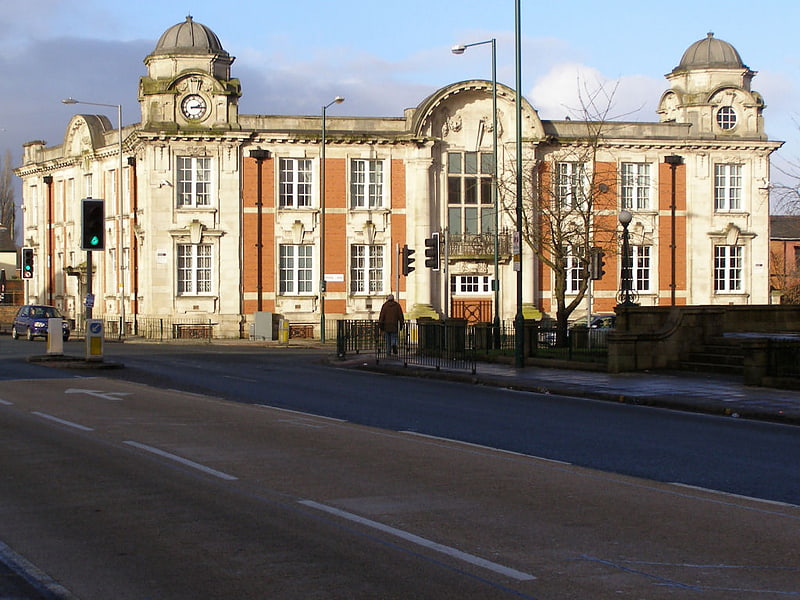
Radcliffe Town Hall is a municipal structure in Spring Lane in Radcliffe, Greater Manchester, England. The town hall, which was the headquarters of Radcliffe Borough Council, is a locally listed building.[6]
Bury Transport Museum
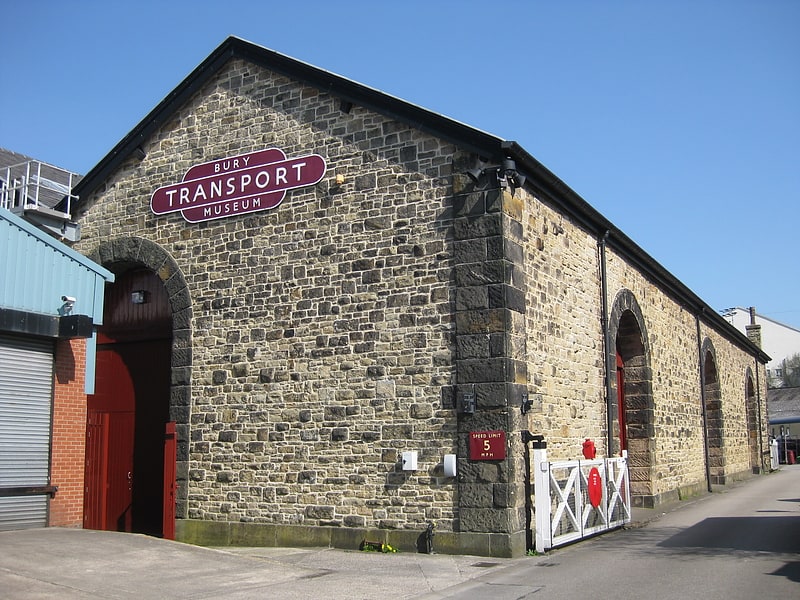
Bury Transport Museum is a transport museum in Bury, Greater Manchester, situated in the former Castlecroft Goods Warehouse, a Grade II listed building from 1846, on Castlecroft Road, with the main entrance from Bolton Street, BL9 0EY.
It was started in 1973 by volunteers of the East Lancashire Railway, had to close in 2003 because of roof problems but opened again in 2010.[7]
Address: Bolton St, BL9 0EY Bury
Holy Trinity Church
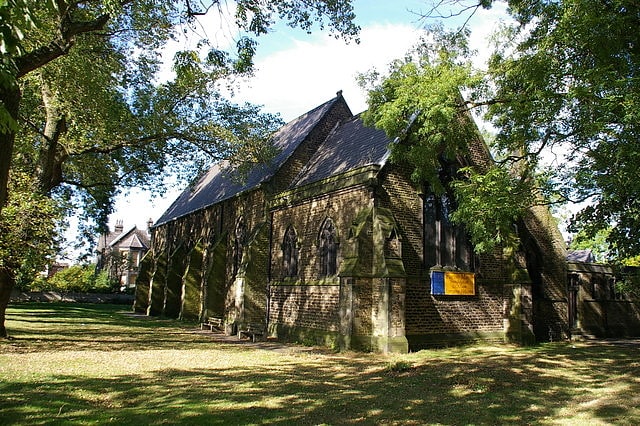
Building. Holy Trinity Church is in Spring Street, Bury, Greater Manchester, England. It is a redundant Anglican parish church in the diocese of Manchester. The church is recorded in the National Heritage List for England as a designated Grade II listed building.[8]
Bury Town Hall
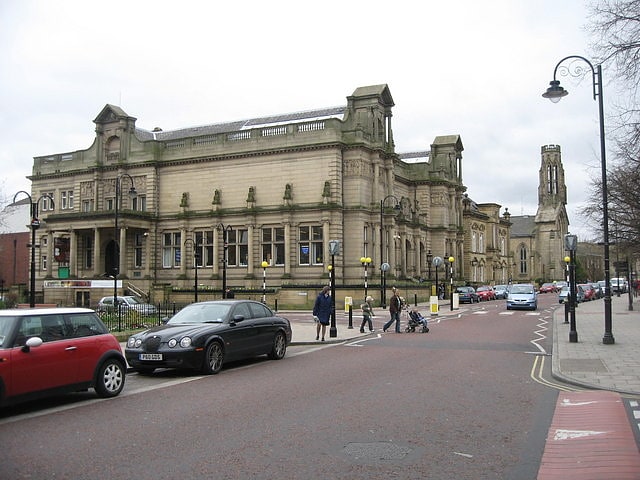
Museum in Bury, England. Bury Art Museum is a public museum and art gallery in the town of Bury, Greater Manchester, northern England, owned by Bury Council.
Formerly known as Bury Museum and Art Gallery, it was renamed Bury Art Museum in 2011.
The museum is home to the Wrigley Collection, an assemblage of over two hundred oil paintings, watercolours, prints and ceramics accumulated by the Victorian paper manufacturer Thomas Wrigley (27 June 1808 – 26 January 1880). The collection includes works by Turner, Constable, and Landseer. The donation of his collection to Bury was the impetus for the foundation and construction of the museum and art gallery. The building was designed by the Manchester firm of Woodhouse and Willoughby. Donations of artworks quickly followed its opening on 9 October 1901 by the Earl of Derby, including donations from the town's Member of Parliament James Kenyon.
In 2005, a £1.2 million refurbishment was carried out, designed to provide a brand new museum, art gallery and library all under one roof. This includes a combined Museum and Archives Centre which, based on a radical re-think, uses artefacts, documentation and art to tell the story of the town. The most recent renovation includes modern artefacts such as iPods and electric iRobot vacuum cleaners.
The council decided in 2006 to sell Lowry's painting The Riverbank at auction in order to fund part of its social services budget shortfall. This has resulted in the government's Museums, Libraries and Archives Council (MLA) removing Bury Council's accredited museum status. The authority will now have limited funding options and will be ineligible for some grants.[9]
Peel Memorial
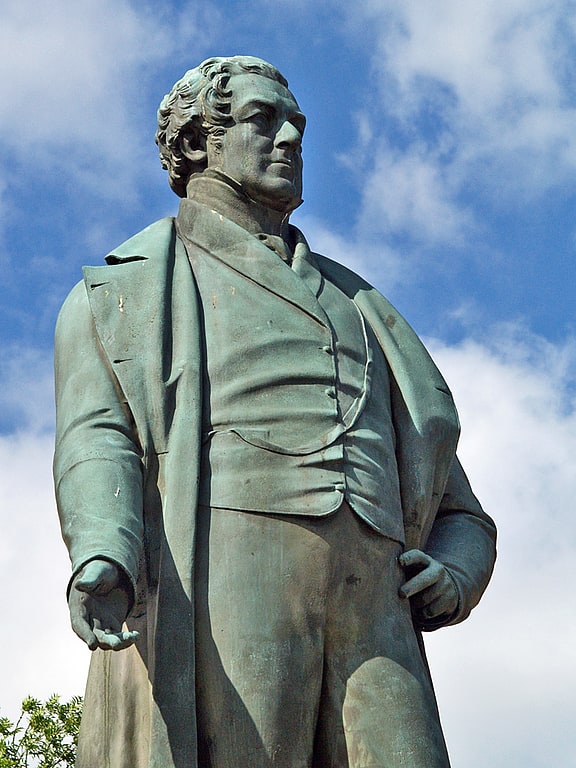
Statue by Edward Hodges Baily. The Peel Memorial is a public statue by Edward Hodges Baily, a nineteenth-century British artist best known for his sculpture of Nelson on Nelson's Column. It is located in the centre of Bury, Greater Manchester. The statue commemorates the life of Sir Robert Peel, twice UK Prime Minister and founder of the British Conservative Party, who was born in Bury.
The statue is of bronze, and stands 3.5m high. Peel is depicted in contemporary dress, "addressing the House of Commons on the memorable subject of Free Trade"
The statue is mounted on a granite pedestal 3.66m high. The front of the pedestal bears the Peel family coat of arms and the word "Peel" in bronze capital letters. On the left and right sides are bronze bas-reliefs representing Commerce and Navigation. On the back of the pedestal is a circular bronze panel containing a quotation from one of Peel's speeches.
The statue was originally surrounded by an iron railing with gas lights at each corner, although this was later removed.[10]
Address: 5-10 Market Pl, BL9 0LD Bury
Heaton Park Reservoir
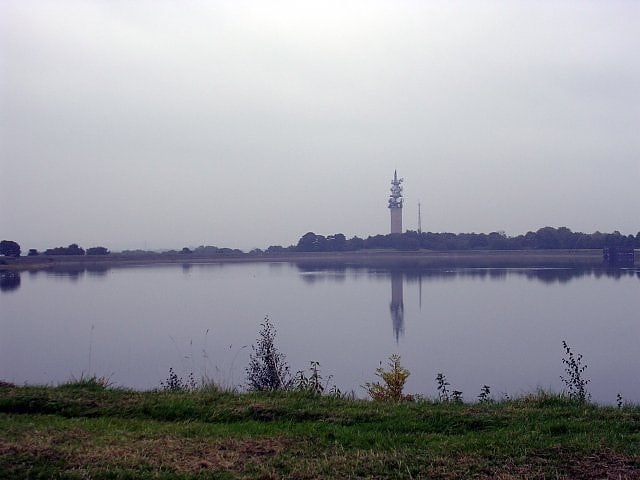
Reservoir in England. Heaton Park Reservoir is a granite sided reservoir in the North-West of England, on the border between the City of Manchester and Bury and is owned by United Utilities, and can be found within the grounds of Heaton Park. Heaton Park BT Tower lies on the banks of the reservoir, which is close to Junction 18 of the M60 motorway.
An aqueduct carrying water from Haweswater, in the Lake District, to Manchester terminates at Heaton Park Reservoir. The aqueduct was inaugurated in June 1955, is 82 miles (132 km) in length and carries up to 100 million imperial gallons (450,000 m3) of water per day under the force of gravity.
In 2008, a £3.5 million Ultra-Violet (UV) disinfection plant was installed at Heaton Park water treatment works to meet water quality requirements. The UV building was designed to nestle within the embankment of the existing service reservoir.[11]